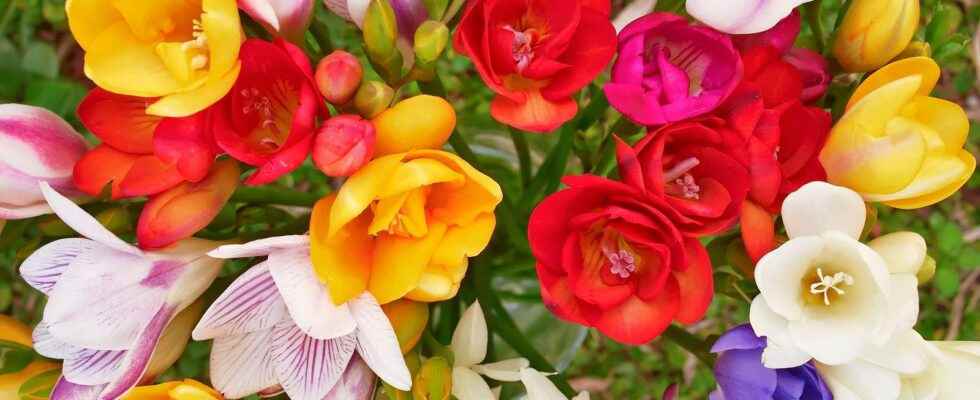Easy to grow, these flowers are appreciated for their colors varieties and their fragrance that perfumes the garden as well as your interior, in a bouquet of season. Take advantage of their flowering from April to September.
Appellations
Freesia (Freesia), also called ” Lily of the valley du Cap” is a small perennial plant bulbous which is a member of the family Iridaceae (Iridaceae).
Botanical description of freesia
The bulbs (corms) placed in the ground form arched stems about 50 centimeters high and bear about ten flowers each, surrounded by foliage in the shape of a trumpet or funnel. The very fragrant, trumpet-shaped flowers offer a multitude of colors: red, yellow, purple, pink, orange or white.
Origins of freesia
Freesias are native to South Africa and more specifically, the Cape of Good Hope.
Cultural requirements of freesia
Plant these little bulbs in humus-rich, well-drained soil (with a bed of sand or gravel at the bottom) because freesias do not appreciateexcess water. Two planting periods are possible:
- planting in April and May for summer flowering, from July to September;
- planting under cover fall for spring flowering, in April and May.
A semi-shaded or sunny location is suitable for them to develop. Whether in the ground or in a container, space each bulb 5 to 10 centimeters apart depending on the desired result and plant them five centimeters deep. Make sure the soil is always fresh. For this, you can install a vegetable mulch. In spring, add a little special bulb fertilizer once a week. In cold regions, it is advisable to plant them in pots to overwinter them more easily. Install stakes in order to maintain the stems which can bend under the weight of the multiple flowers.
Once they have faded, remove the faded flowers or leave one or two to save seeds. Leave the foliage in place to dry completely before digging them up so that the bulbs replenish their reserves.
The bulbs are not very hardy and fear frosts below 0°C. tuck them in if you live in an area with winters very cold. Grown in pots, leave them in a sheltered spot or grown in the ground in a cold region, dry the bulbs and store them in a net placed in a bright room, outside gel and well ventilated, while waiting spring next to plant them.
Use of freesia
Use freesias of different colors as cut flowers to compose spring bouquets, mixed with tulips and ranunculus or just to place in soliflores. Its longevity in vase is very appreciated. Plant them also in pots or planters, tight to create tufts, in order to bring color from the first days of spring. Mix freesias in a bed of perennials to create movementplay with heights and hues.
You will also be interested
Interested in what you just read?
